2011 MERCEDES-BENZ SLK300 recommended oil
[x] Cancel search: recommended oilPage 7 of 312

Automatic locking when driving
......108
Automatic shift program ....................88
Automatic transmission ..................... 85
Automatic shift program ..................88
Gear range indicator ........................88
Gear ranges ..................................... 88
Gear selector lever ...........................
86
Kickdown ......................................... 87
Kickdown (manual shift program) .... 92
Manual shift program ....................... 90
One-touch gearshifting ....................89
Program mode indicator ..................89
Program mode selector switch
(automatic shift program) ................88
Program mode selector switch
(manual shift program) ....................90
Shifting procedure ........................... 86
Steering wheel gearshift control ...... 89
Transmission position indicator ....... 87
Transmission positions .................... 87
AUX socket ........................................ 145
Axle oils .............................................. 301B
Back button ....................................... 116
Backrest see Seats
Backup lamps
Messages in the multifunction
display ........................................... 252
Bar (air pressure unit) ....................... 217
BAS (Brake Assist System) ................. 49
Batteries, SmartKey
Checking condition ..........................57
Replacing ....................................... 266
Battery, Vehicle ................................. 282
Charging ........................................ 283
Jump starting ................................. 283
Messages in the multifunction
display ........................................... 249
Bead (tire) .......................................... 217
Beverage holders see Cup holders
Bluetooth ®
settings .......................... 120
Brake Assist System see BAS Brake fluid
Checking level ............................... 197
Messages in the multifunction
display
........................................... 244
Brake lamps
Cleaning lenses ............................. 229
Brake pads
Messages in the multifunction
display ........................................... 243
Brakes ................................................ 222
High-performance brake system .... 223
Parking brake ................................... 83
Warning lamp ................................. 257
Break-in period .................................. 190
Bulbs see Replacing bulbs C
CAC (Customer Assistance Center) ...21
California retail buyers and
lessees, important notice for .............19
Calls (phone) ..............................
110, 146
Can holders see Cup holders
Capacities and recommended
fuel/lubricants .................................. 300
Carpets, cleaning .............................. 231
CD player ............................................ 131
Central locking
Automatic ................................ 59, 108
Locking/unlocking from inside ........ 59
SmartKey ......................................... 56
Central locking/unlocking switch .....59
Certification label .............................. 292
Children in the vehicle
Air bags ........................................... 33
Indicator lamp, passenger front
air bag off ........................................ 37
Infant and child restraint systems .... 45
OCS (Occupant Classification
System) ........................................... 37
Safety notes ..................................... 45
Child safety
see Children in the vehicle
Chrome-plated exhaust tip,
cleaning .............................................. 232
Cigarette lighter ................................ 177 Index
5 171_AKB; 3; 60, en-US
d2ureepe,
Version: 2.11.8.1 2009-05-11T16:00:23+02:00 - Seite 5
Page 10 of 312

Consumption .................................
193
Messages in the multifunction
display
........................................... 250
Oil dipstick ..................................... 193
Recommended engine oils and oil
filter ............................................... 302
ESP ®
(Electronic Stability
Program) .............................................. 49
ETS .................................................. 50
Messages in the multifunction
display ........................................... 237
Warning lamp ................................. 260
ETD (Emergency Tensioning
Device) ................................................. 43
Safety guidelines ............................. 34
ETS (Electronic Traction System) ....... 50
Express operation Power windows ................................ 78
Exterior lamp switch ........................... 71
Exterior rear view mirrors ..................68
Parking position ............................... 69
Exterior view of vehicle ......................24 F
Fastening the seat belts .....................42
First aid kit .........................................
234
Flat tire ............................................... 273
Lowering the vehicle ......................281
Mounting the spare wheel ............. 277
Preparing the vehicle .....................273
Spare wheel ........................... 273, 300
TIREFIT (tire repair kit) ................... 273
Floormats ........................................... 187
Fluids
Automatic transmission fluid ......... 301
Brake fluid ..................................... 301
Capacities ...................................... 300
Engine coolant ............................... 301
Engine oil ....................................... 301
Hydraulic fluid ................................ 302
Manual transmission oil ................. 301
Power steering fluid ....................... 301
Washer and headlamp cleaning
system ........................................... 302
Fog lamps ............................................. 73
Messages in the multifunction
display ................................... 252, 254Front air bags
see Air bags
Front lamps
see Headlamps
Front seat head restraints
see Head restraints
Fuel ..................................................... 190
Additives ........................................ 304
Capacity, fuel tank ......................... 301
Drive sensibly–safe fuel .................221
Fuel consumption statistics ...........109
Fuel filler flap and cap ................... 191
Fuel tank reserve warning
lamp ........................................ 26, 261
Premium unleaded gasoline ...........303
Refueling ........................................ 190
Requirements ................................ 303
Fuel filler flap ..................................... 191
Fuels, coolants, lubricants etc. ........300
Fuel tank Capacity ........................................ 301
Fuel filler flap and cap ................... 191
Refueling ........................................ 190
Fuses .................................................. 288 G
Garage door opener .................... 30, 183
Gasoline see Fuel
GAWR (Gross Axle Weight Rating) ...218
Gear range ........................................... 88
Indicator .......................................... 88
Limiting ............................................ 89
Shifting into optimal ........................90
Gear selector lever .............................. 86
Cleaning ......................................... 231
Gearshift pattern ............................. 86
Lock ........................................... 80, 86
Shifting procedure ........................... 86
Transmission position indicator ....... 87
Transmission positions .................... 87
Gearshift lever ..................................... 84
Gearshift pattern ............................. 84
Generator
see Alternator
Global locking/unlocking
see Key, SmartKey 8
Index 171_AKB; 3; 60, en-US
d2ureepe,
Version: 2.11.8.1 2009-05-11T16:00:23+02:00 - Seite 8
Page 212 of 312
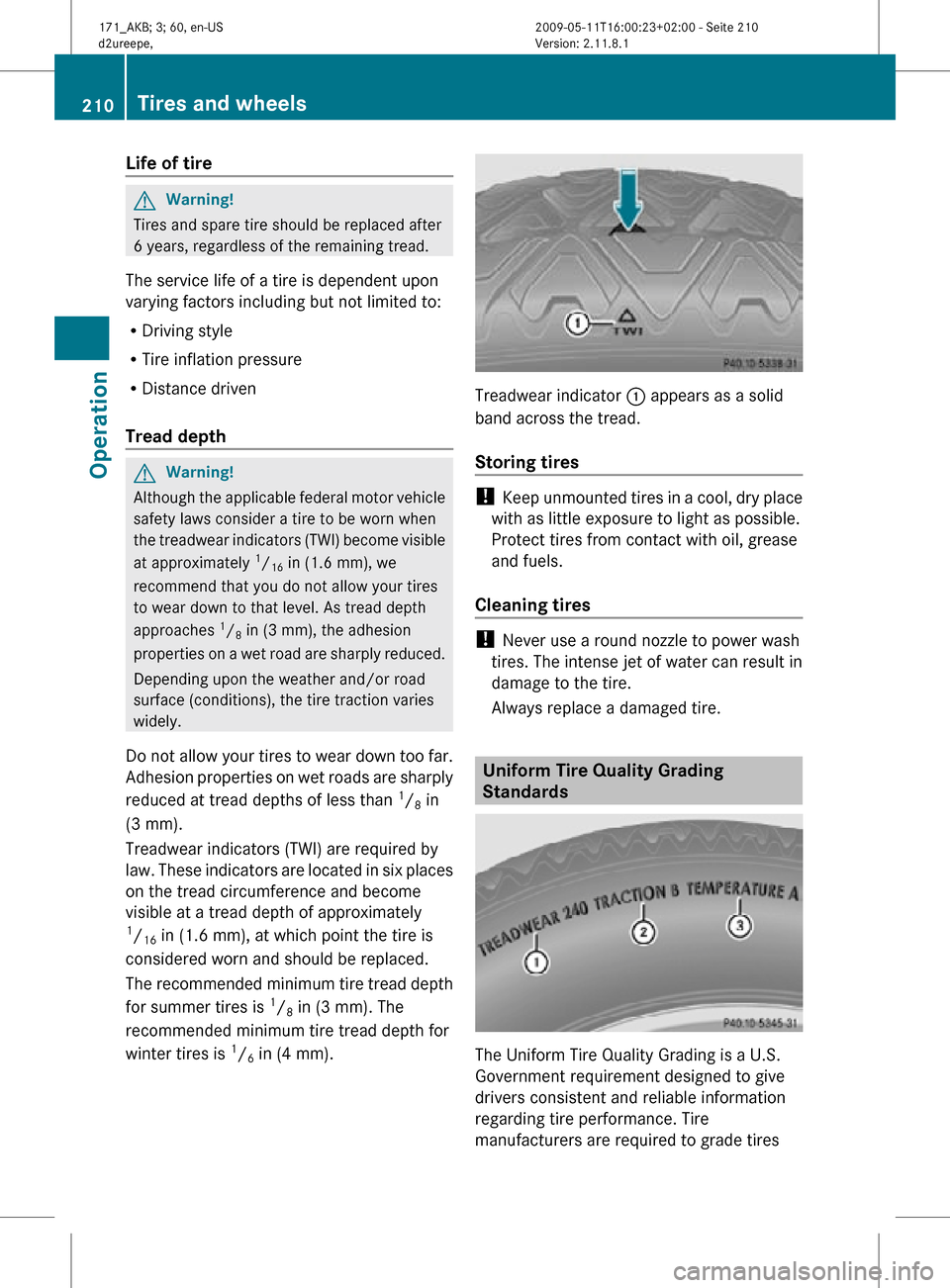
Life of tire
G
Warning!
Tires and spare tire should be replaced after
6 years, regardless of the remaining tread.
The service life of a tire is dependent upon
varying factors including but not limited to:
R Driving style
R Tire inflation pressure
R Distance driven
Tread depth G
Warning!
Although the applicable federal motor vehicle
safety laws consider a tire to be worn when
the treadwear indicators (TWI) become visible
at approximately 1
/ 16 in (1.6 mm), we
recommend that you do not allow your tires
to wear down to that level. As tread depth
approaches 1
/ 8 in (3 mm), the adhesion
properties on a wet road are sharply reduced.
Depending upon the weather and/or road
surface (conditions), the tire traction varies
widely.
Do not allow your tires to wear down too far.
Adhesion properties on wet roads are sharply
reduced at tread depths of less than 1
/ 8 in
(3 mm).
Treadwear indicators (TWI) are required by
law. These indicators are located in six places
on the tread circumference and become
visible at a tread depth of approximately
1 / 16 in (1.6 mm), at which point the tire is
considered worn and should be replaced.
The recommended minimum tire tread depth
for summer tires is 1
/ 8 in (3 mm). The
recommended minimum tire tread depth for
winter tires is 1
/ 6 in (4 mm). Treadwear indicator
: appears as a solid
band across the tread.
Storing tires !
Keep unmounted tires in a cool, dry place
with as little exposure to light as possible.
Protect tires from contact with oil, grease
and fuels.
Cleaning tires !
Never use a round nozzle to power wash
tires. The intense jet of water can result in
damage to the tire.
Always replace a damaged tire. Uniform Tire Quality Grading
Standards
The Uniform Tire Quality Grading is a U.S.
Government requirement designed to give
drivers consistent and reliable information
regarding tire performance. Tire
manufacturers are required to grade tires210
Tires and wheelsOperation
171_AKB; 3; 60, en-US
d2ureepe,
Version: 2.11.8.1 2009-05-11T16:00:23+02:00 - Seite 210
Page 229 of 312
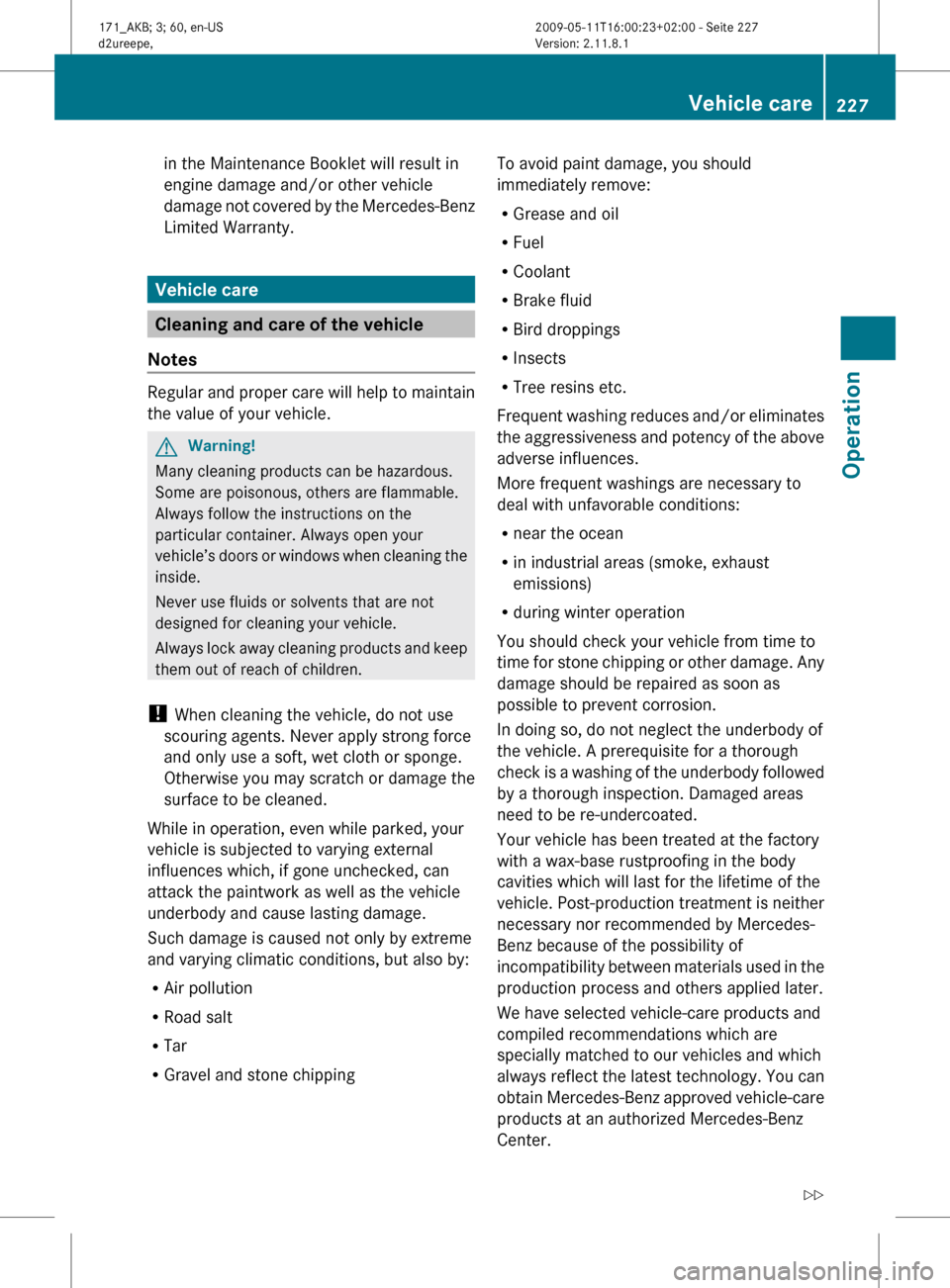
in the Maintenance Booklet will result in
engine damage and/or other vehicle
damage
not covered by the Mercedes-Benz
Limited Warranty. Vehicle care
Cleaning and care of the vehicle
Notes Regular and proper care will help to maintain
the value of your vehicle.
G
Warning!
Many cleaning products can be hazardous.
Some are poisonous, others are flammable.
Always follow the instructions on the
particular container. Always open your
vehicle’s
doors or windows when cleaning the
inside.
Never use fluids or solvents that are not
designed for cleaning your vehicle.
Always lock away cleaning products and keep
them out of reach of children.
! When cleaning the vehicle, do not use
scouring agents. Never apply strong force
and only use a soft, wet cloth or sponge.
Otherwise you may scratch or damage the
surface to be cleaned.
While in operation, even while parked, your
vehicle is subjected to varying external
influences which, if gone unchecked, can
attack the paintwork as well as the vehicle
underbody and cause lasting damage.
Such damage is caused not only by extreme
and varying climatic conditions, but also by:
R Air pollution
R Road salt
R Tar
R Gravel and stone chipping To avoid paint damage, you should
immediately remove:
R
Grease and oil
R Fuel
R Coolant
R Brake fluid
R Bird droppings
R Insects
R Tree resins etc.
Frequent
washing reduces and/or eliminates
the aggressiveness and potency of the above
adverse influences.
More frequent washings are necessary to
deal with unfavorable conditions:
R near the ocean
R in industrial areas (smoke, exhaust
emissions)
R during winter operation
You should check your vehicle from time to
time for stone chipping or other damage. Any
damage should be repaired as soon as
possible to prevent corrosion.
In doing so, do not neglect the underbody of
the vehicle. A prerequisite for a thorough
check is a washing of the underbody followed
by a thorough inspection. Damaged areas
need to be re-undercoated.
Your vehicle has been treated at the factory
with a wax-base rustproofing in the body
cavities which will last for the lifetime of the
vehicle. Post-production treatment is neither
necessary nor recommended by Mercedes-
Benz because of the possibility of
incompatibility between materials used in the
production process and others applied later.
We have selected vehicle-care products and
compiled recommendations which are
specially matched to our vehicles and which
always reflect the latest technology. You can
obtain Mercedes-Benz approved vehicle-care
products at an authorized Mercedes-Benz
Center. Vehicle care
227
Operation
171_AKB; 3; 60, en-US
d2ureepe, Version: 2.11.8.1 2009-05-11T16:00:23+02:00 - Seite 227 Z
Page 272 of 312
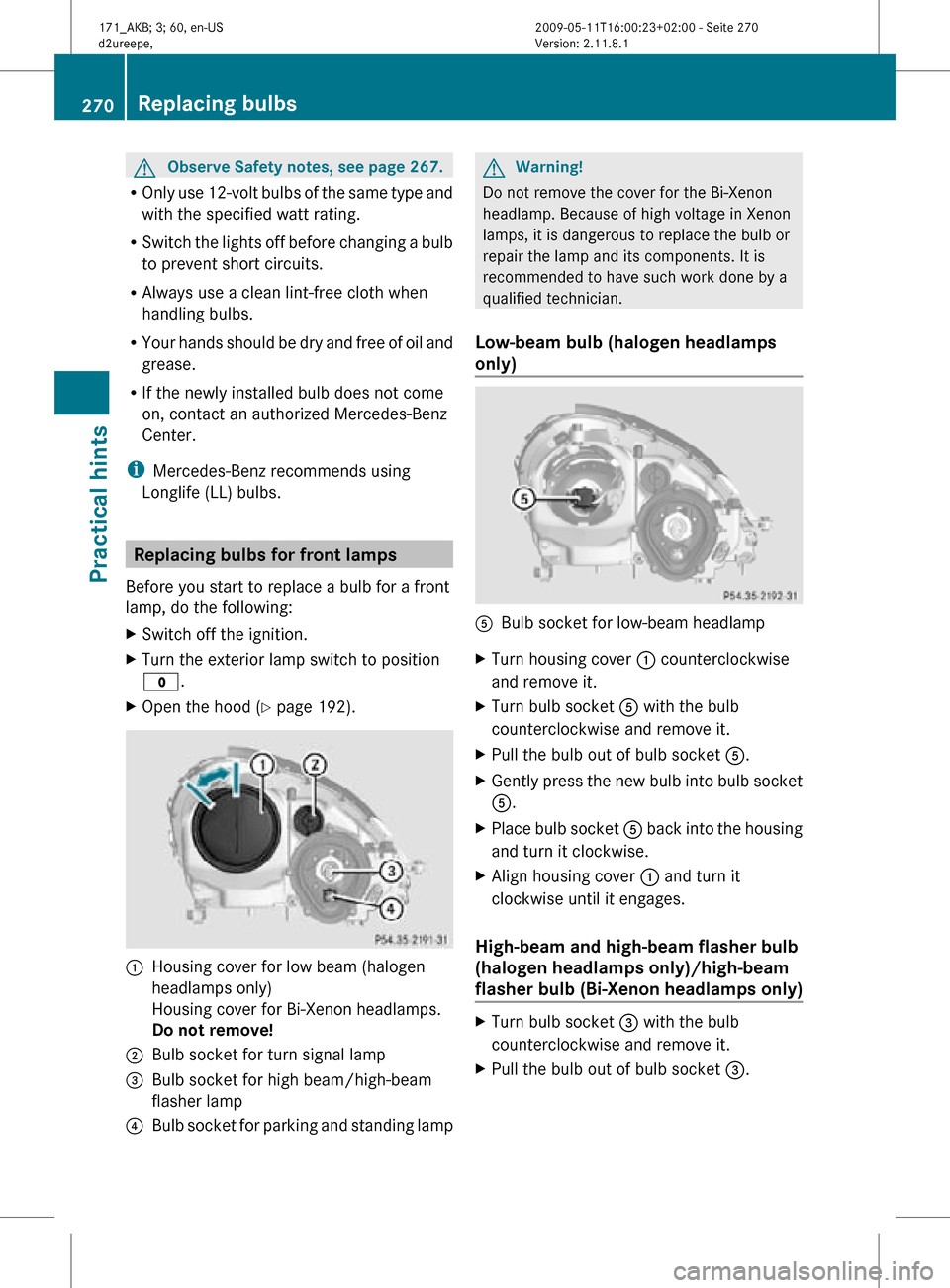
G
Observe Safety notes, see page 267.
R Only use 12-volt bulbs of the same type and
with the specified watt rating.
R Switch the lights off before changing a bulb
to prevent short circuits.
R Always use a clean lint-free cloth when
handling bulbs.
R Your hands should be dry and free of oil and
grease.
R If the newly installed bulb does not come
on, contact an authorized Mercedes-Benz
Center.
i Mercedes-Benz recommends using
Longlife (LL) bulbs. Replacing bulbs for front lamps
Before you start to replace a bulb for a front
lamp, do the following:
X Switch off the ignition.
X Turn the exterior lamp switch to position
$.
X Open the hood (Y page 192). :
Housing cover for low beam (halogen
headlamps only)
Housing cover for Bi-Xenon headlamps.
Do not remove!
; Bulb socket for turn signal lamp
= Bulb socket for high beam/high-beam
flasher lamp
? Bulb socket for parking and standing lamp G
Warning!
Do not remove the cover for the Bi-Xenon
headlamp. Because of high voltage in Xenon
lamps, it is dangerous to replace the bulb or
repair the lamp and its components. It is
recommended to have such work done by a
qualified technician.
Low-beam bulb (halogen headlamps
only) A
Bulb socket for low-beam headlamp
X Turn housing cover : counterclockwise
and remove it.
X Turn bulb socket A with the bulb
counterclockwise and remove it.
X Pull the bulb out of bulb socket A.
X Gently press the new bulb into bulb socket
A.
X Place bulb socket A back into the housing
and turn it clockwise.
X Align housing cover : and turn it
clockwise until it engages.
High-beam and high-beam flasher bulb
(halogen headlamps only)/high-beam
flasher bulb (Bi-Xenon headlamps only) X
Turn bulb socket = with the bulb
counterclockwise and remove it.
X Pull the bulb out of bulb socket =.270
Replacing bulbsPractical hints
171_AKB; 3; 60, en-US
d2ureepe,
Version: 2.11.8.1 2009-05-11T16:00:23+02:00 - Seite 270
Page 305 of 312
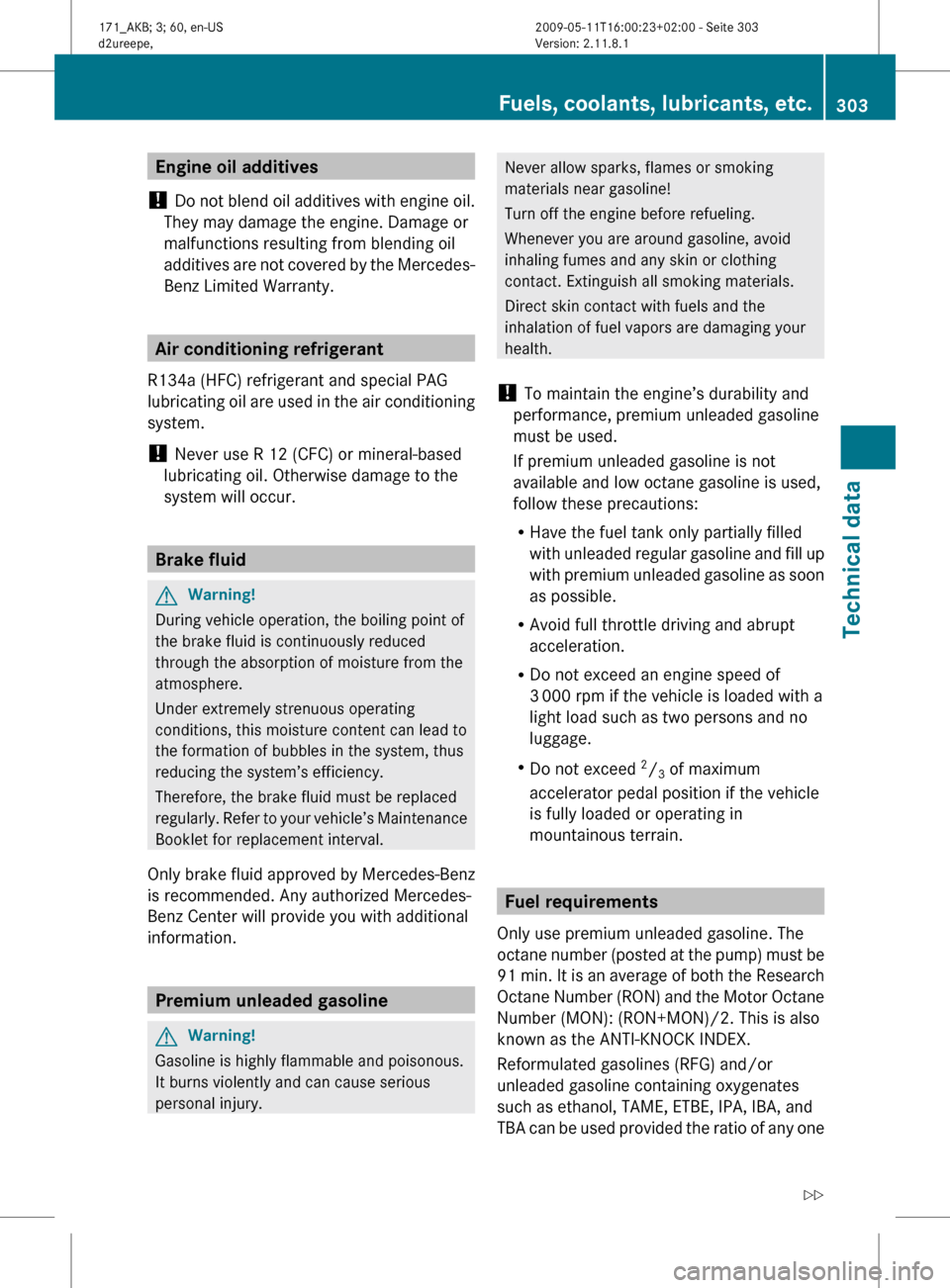
Engine oil additives
! Do
not blend oil additives with engine oil.
They may damage the engine. Damage or
malfunctions resulting from blending oil
additives are not covered by the Mercedes-
Benz Limited Warranty. Air conditioning refrigerant
R134a (HFC) refrigerant and special PAG
lubricating
oil are used in the air conditioning
system.
! Never use R 12 (CFC) or mineral-based
lubricating oil. Otherwise damage to the
system will occur. Brake fluid
G
Warning!
During vehicle operation, the boiling point of
the brake fluid is continuously reduced
through the absorption of moisture from the
atmosphere.
Under extremely strenuous operating
conditions, this moisture content can lead to
the formation of bubbles in the system, thus
reducing the system’s efficiency.
Therefore, the brake fluid must be replaced
regularly.
Refer to your vehicle’s Maintenance
Booklet for replacement interval.
Only brake fluid approved by Mercedes-Benz
is recommended. Any authorized Mercedes-
Benz Center will provide you with additional
information. Premium unleaded gasoline
G
Warning!
Gasoline is highly flammable and poisonous.
It burns violently and can cause serious
personal injury. Never allow sparks, flames or smoking
materials near gasoline!
Turn off the engine before refueling.
Whenever you are around gasoline, avoid
inhaling fumes and any skin or clothing
contact. Extinguish all smoking materials.
Direct skin contact with fuels and the
inhalation of fuel vapors are damaging your
health.
! To maintain the engine’s durability and
performance, premium unleaded gasoline
must be used.
If premium unleaded gasoline is not
available and low octane gasoline is used,
follow these precautions:
R Have the fuel tank only partially filled
with
unleaded regular gasoline and fill up
with premium unleaded gasoline as soon
as possible.
R Avoid full throttle driving and abrupt
acceleration.
R Do not exceed an engine speed of
3 000 rpm if the vehicle is loaded with a
light load such as two persons and no
luggage.
R Do not exceed 2
/ 3 of maximum
accelerator pedal position if the vehicle
is fully loaded or operating in
mountainous terrain. Fuel requirements
Only use premium unleaded gasoline. The
octane
number (posted at the pump) must be
91 min. It is an average of both the Research
Octane Number (RON) and the Motor Octane
Number (MON): (RON+MON)/2. This is also
known as the ANTI-KNOCK INDEX.
Reformulated gasolines (RFG) and/or
unleaded gasoline containing oxygenates
such as ethanol, TAME, ETBE, IPA, IBA, and
TBA can be used provided the ratio of any one Fuels, coolants, lubricants, etc.
303
Technical data
171_AKB; 3; 60, en-US
d2ureepe, Version: 2.11.8.1 2009-05-11T16:00:23+02:00 - Seite 303 Z
Page 306 of 312
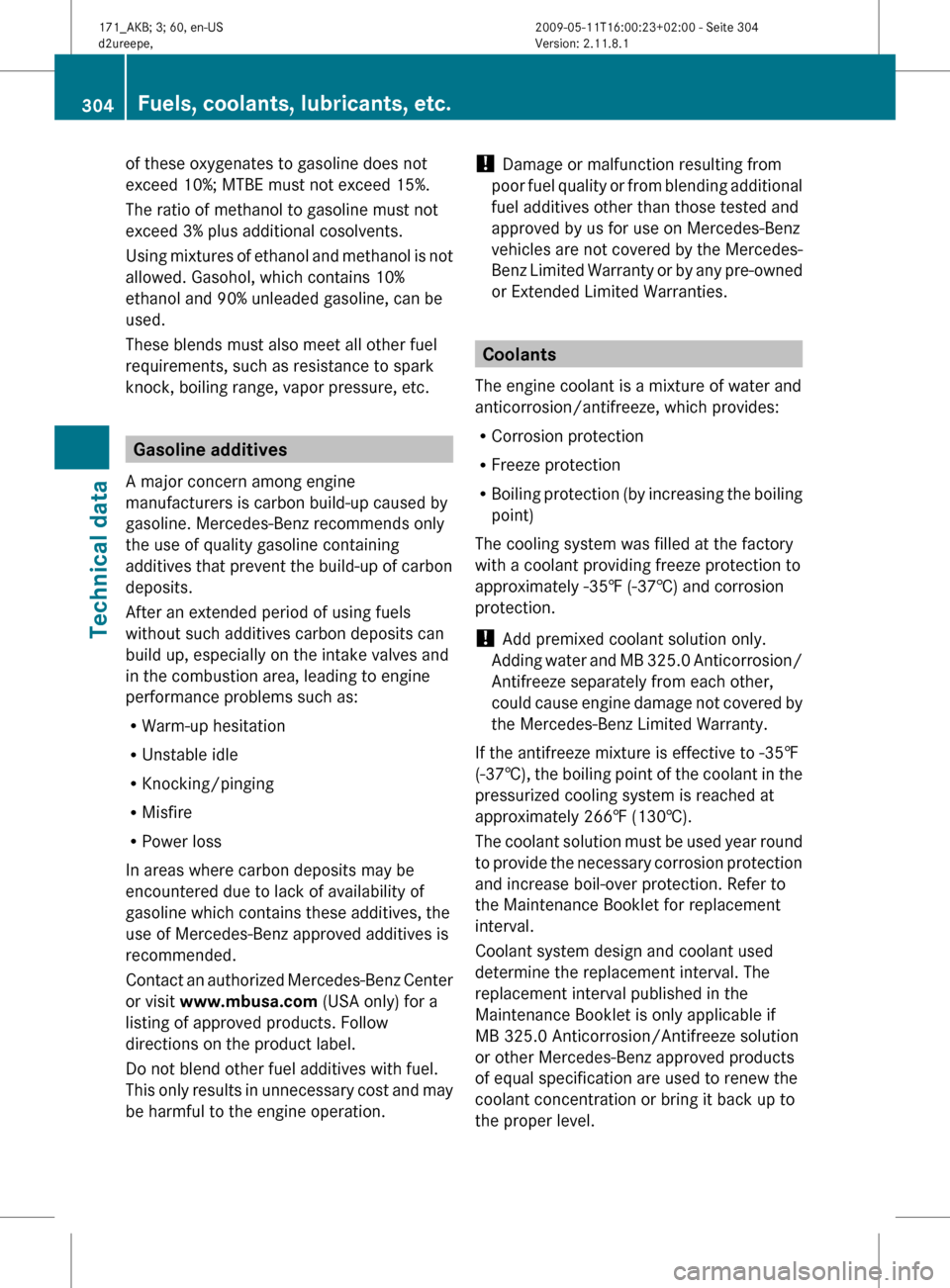
of these oxygenates to gasoline does not
exceed 10%; MTBE must not exceed 15%.
The ratio of methanol to gasoline must not
exceed 3% plus additional cosolvents.
Using
mixtures of ethanol and methanol is not
allowed. Gasohol, which contains 10%
ethanol and 90% unleaded gasoline, can be
used.
These blends must also meet all other fuel
requirements, such as resistance to spark
knock, boiling range, vapor pressure, etc. Gasoline additives
A major concern among engine
manufacturers is carbon build-up caused by
gasoline. Mercedes-Benz recommends only
the use of quality gasoline containing
additives that prevent the build-up of carbon
deposits.
After an extended period of using fuels
without such additives carbon deposits can
build up, especially on the intake valves and
in the combustion area, leading to engine
performance problems such as:
R Warm-up hesitation
R Unstable idle
R Knocking/pinging
R Misfire
R Power loss
In areas where carbon deposits may be
encountered due to lack of availability of
gasoline which contains these additives, the
use of Mercedes-Benz approved additives is
recommended.
Contact
an authorized Mercedes-Benz Center
or visit www.mbusa.com (USA only) for a
listing of approved products. Follow
directions on the product label.
Do not blend other fuel additives with fuel.
This only results in unnecessary cost and may
be harmful to the engine operation. !
Damage or malfunction resulting from
poor
fuel quality or from blending additional
fuel additives other than those tested and
approved by us for use on Mercedes-Benz
vehicles are not covered by the Mercedes-
Benz Limited Warranty or by any pre-owned
or Extended Limited Warranties. Coolants
The engine coolant is a mixture of water and
anticorrosion/antifreeze, which provides:
R Corrosion protection
R Freeze protection
R Boiling
protection (by increasing the boiling
point)
The cooling system was filled at the factory
with a coolant providing freeze protection to
approximately -35‡ (-37†) and corrosion
protection.
! Add premixed coolant solution only.
Adding water and MB 325.0 Anticorrosion/
Antifreeze separately from each other,
could cause engine damage not covered by
the Mercedes-Benz Limited Warranty.
If the antifreeze mixture is effective to -35‡
(-37†), the boiling point of the coolant in the
pressurized cooling system is reached at
approximately 266‡ (130†).
The coolant solution must be used year round
to provide the necessary corrosion protection
and increase boil-over protection. Refer to
the Maintenance Booklet for replacement
interval.
Coolant system design and coolant used
determine the replacement interval. The
replacement interval published in the
Maintenance Booklet is only applicable if
MB 325.0 Anticorrosion/Antifreeze solution
or other Mercedes-Benz approved products
of equal specification are used to renew the
coolant concentration or bring it back up to
the proper level. 304
Fuels, coolants, lubricants, etc.
Technical data
171_AKB; 3; 60, en-US
d2ureepe,
Version: 2.11.8.1 2009-05-11T16:00:23+02:00 - Seite 304